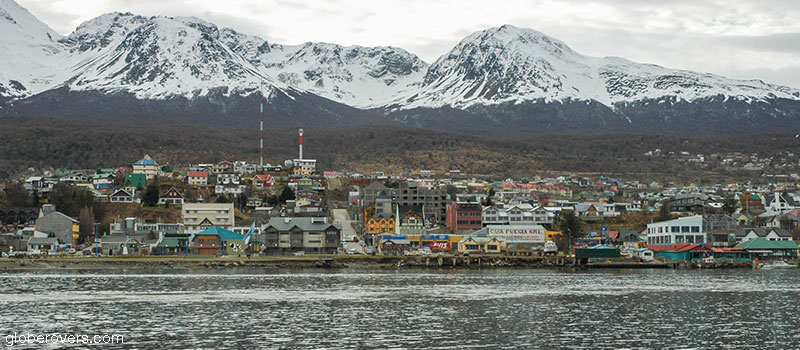
Argentina is a world in one. A country that offers rose-red deserts, snow-capped mountains, massive glaciers, rugged landscapes, vast plains, great food and wine, and the best tango dancing in the world. We travel all the way from the Bolivian border at the northern tip of Argentina down to Ushuaia, the southernmost town in the world. Along the way we explore the world-renowned Iguazú Falls, we dance the tango in the nation’s charming capital, we crawl close to the wildlife of Peninsula Valdés, and walk on glaciers. Viva! Argentina.
Argentina, from north to south, is a long way down but what a pleasant country to get lost in any direction. Come along as we explore the wildlife, deserts, glaciers, mountains, coastline, cities, and more!
Why travel to Argentina?
- The low-down: Argentina is a fascinating country. Whether you travel to enjoy the mountains, beaches, history, glaciers, food, wildlife, vast plains, waterfalls, song and dance… Argentina has it all.
- The brightest highlight: Argentina has a highlight for everybody out there. For me, it was the food and wine that melted my heart – and the street tangos!
- Intrepid destination: Absolutely. Most of the country is totally off the beaten track!
- Globerovers score (10 is highest): I have travelled all over Argentina and loved every moment. I’ll score it 9.5/10.
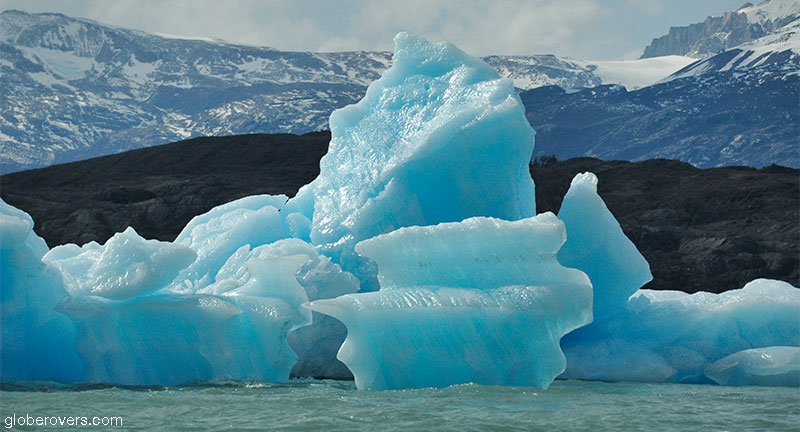
Table of Contents
Welcome to Argentina
Thinking about Argentina, you may get visions of large stadiums packed with chanting football fans. You also may think of Evita Perón, or rugged snow-capped mountains, or even large chunks of BBQ’d steaks and tango dancing. Argentina is all of this, and a lot more.
Argentina is one of the most diverse and most pristine places on planet earth. Unquestionably.
From the snow-capped Andes Mountain Range in the west and the red-rock deserts in the north to the swampy Iberá Provincial Reserve to the east and the Patagonian glaciers to the south, it seems like Argentina has it all.
Enjoy some of the best BBQ’s in the world, known as “asado” cooked on a grill, or “parrilla”, while sipping on a Malbec wine from the Mendoza wine region. All of this enjoyment while watching impromptu tango dancing on the cobbled streets of San Telmo in Buenos Aires.

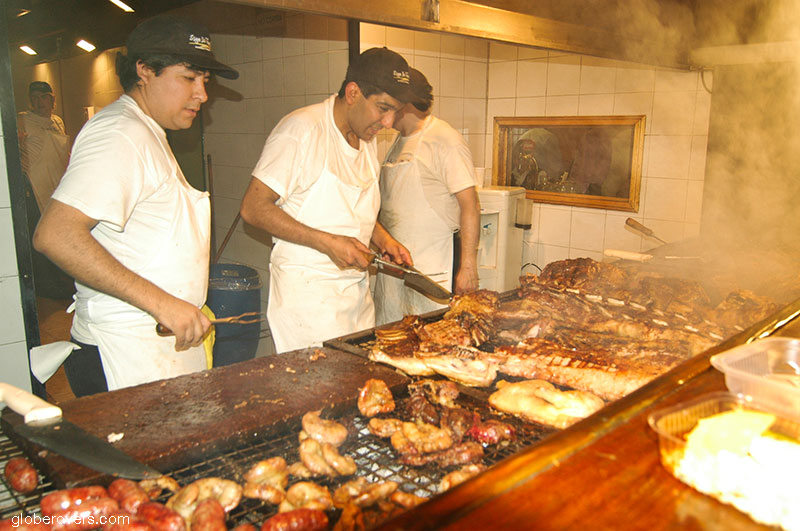
You might already be thinking about taking a week or two to explore this amazing country. The problem is, Argentina is far away from much of the world, and distances within the country are vast. As a starter, the far north to the far south stretches over 5,000 kilometres (3,100 mi).
Once you make it here, you’d better plan on spending at least four weeks, and without a doubt when you leave, you will promise yourself to be back soon with another four weeks or more.
Argentina is a lot more than mountains, glaciers, deserts, waterfalls and wildlife. The country’s best asset is its people, and you will realize it the moment you arrive.
This is a place where family, friends, and even colleagues have a ritual based on sharing a cup of “mate” (pronounced mah-tay), a caffeine-rich drink made from the chopped dried leaves of “yerba mate” soaked in boiling water. Served in a small metal-rimmed hollow calabash gourd and sipped through a metal straw, the drink and straw are shared among several people. This is a country where people dance the tango on the cobbled streets before breakfast!

Argentina is also the birthplace of Eva (Evita) Perón, the First Lady of Argentina from 1946 until her death (aged 33) in 1952 from cervical cancer. Che Guevara, one of the most famous revolutionaries who assisted Fidel Castro to win back Cuba in 1959, was born in Rosario, Santa Fe province. Diego Maradona and Lionel Messi, two of the best footballers in the world, are also from Argentina.
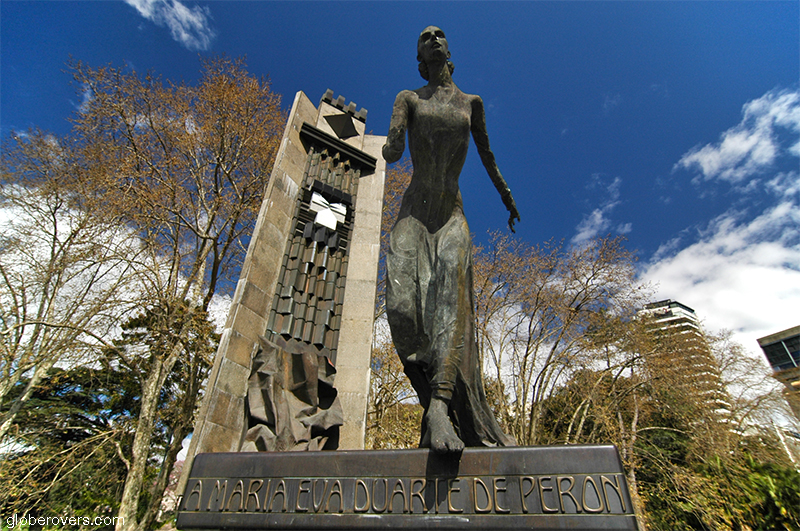
Let’s take the long way down to Ushuaia, the world’s southernmost town, and gateway to Antarctica. While we can’t visit the entire country, we will explore some of the most recommended destinations.
Starting from La Quiaca on the Bolivian border, we travel south to the red mud-brick village of Humahuaca. From here we travel farther south to Salta before we head east to the spectacular Iguazú Falls on the tri-junction of Argentina, Brazil and Paraguay. Buenos Aires is next before heading south to the wildlife at Patagonia’s Peninsula Valdés. Further south, we visit some of the world’s most impressive glaciers in the Los Glaciares National Park before reaching our final destination at Ushuaia and the Parque Nacional Tierra Del Fuego. From here it is a hop, skip, and a jump to the Antarctic Peninsula, but we will leave that for next time.
Humahuaca
Argentina’s northern gateway is the border-crossing at La Quiaca in Argentina and Villazon in Bolivia to the north. This is a border crossing which often requires a lot of patience as queue lines can be very long.
While Argentinians and Bolivians walk freely across the bridge, foreigners must get their passports processed in a building below the bridge which can be tedious and slow.
The rustic town at the heart of the Quebrada de Humahuaca Valley.
Not waiting in line are the hundreds of labourers running back and forth across the border to upload and unload heavy bags and other goods between trucks parked on both sides of the dividing line. The border is not always open to cargo vehicles so all cargo must be carried across the border by manpower.

As you arrive in Argentina, a large yellow road sign will welcome you with “Bienvenidos a La Quiaca – Ushuaia 5,121 kilometres (3,182 mi)”. As you stare at the big number, you will with no doubt get dizzy with the realization that it is a very long way down to Argentina’s most southern town, Ushuaia.
Between the Bolivian border and Ushuaia, known as the “world’s southernmost town”, Argentina has more to offer than we can experience in a lifetime!
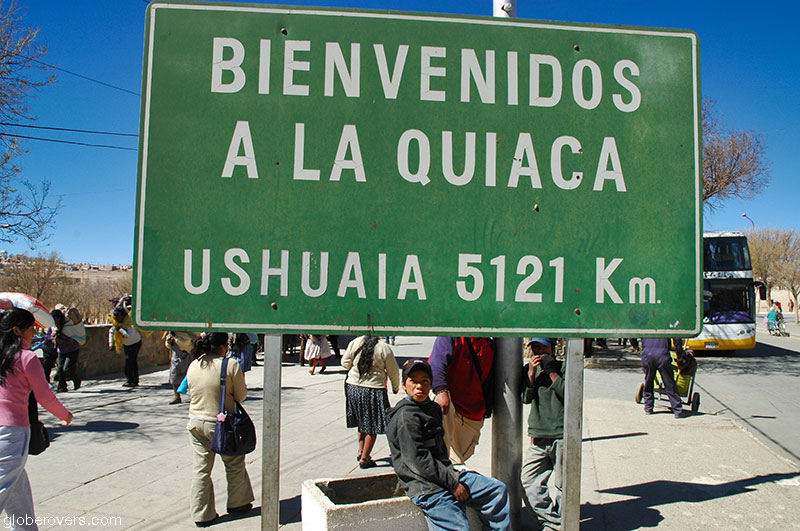
About 160 kilometres (99 mi) south on the road to the town of Salta lies the red mud-brick village of Humahuaca. While the town itself is not one of the country’s highlights, the surrounding narrow mountains and valleys, named Quebrada de Humahuaca, are a vivid red-orange multi-coloured display created by mother nature. Indeed, so incredibly beautiful that it is a UNESCO World Heritage Site.
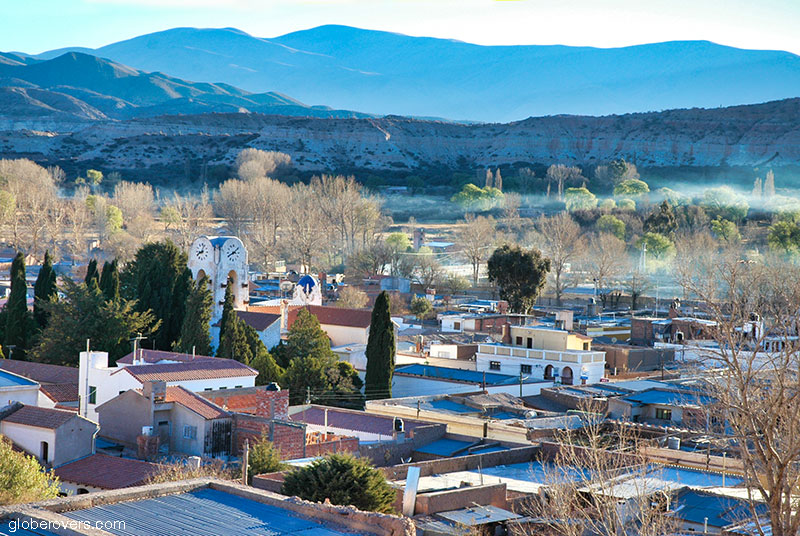
Base yourself in sleepy Humahuaca and head out into the rusty-red valley by horse, on foot, or any other type of transportation fit for a moon landscape. The valley stretches about 155 kilometres (96 mi) from north to south and is bordered by the Andean Plateau to the west and north and by the sub-Andean hills to the east.
Quebrada de Humahuaca, known as Argentina’s Rainbow Valley, has been populated for thousands of years. It is packed with history and natural wonders.
The Grande River (Río Grande) flows through Quebrada de Humahuaca and served as a caravan route to the Inca Empire during the 15th century. The river is mostly dry during the winter months, which made it a perfect highway for ancient explorers.
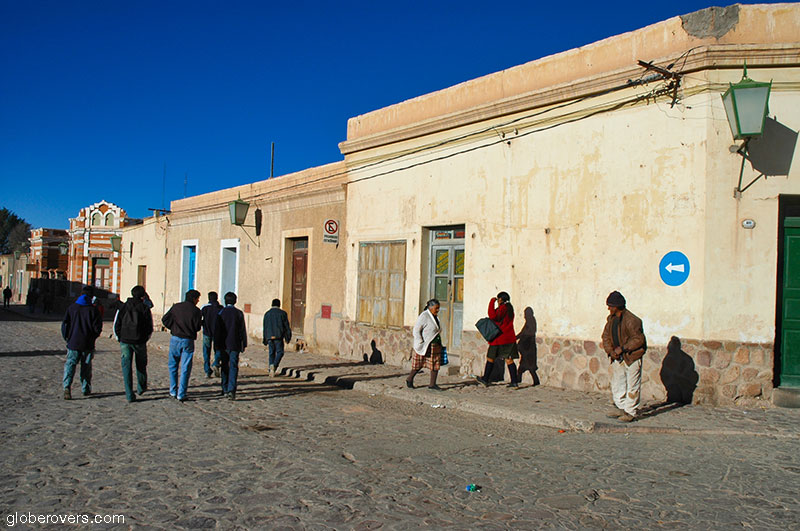
The Spanish conquerors knew these Indian people of the Grande de Jujuy River as the “omaguacas”. According to historians, the name is derived from an Andean Indian legend that makes reference to a people crying: “Humahuacac! Humahuacac!”
The town’s Hispanic foundation dates back to 1591 as it served as a stopover for expeditions to the High Perú.
The non-touristy town of Humahuaca is dotted with adobe houses, cobblestone streets and a quaint plaza.
Humahuaca has narrow cobbled streets, illuminated by colonial-style street lamps and is inhabited by a people clinging to ancient traditions.
The curious traveller will find a few interesting attractions in town such as the Monumento a los Héroes de la Independencia, a monument made from over 70 tons of bronze built in honour of the “Army of North” and the indigenous peoples who fought in the Quebrada de Humahuaca during Argentina’s War of Independence.
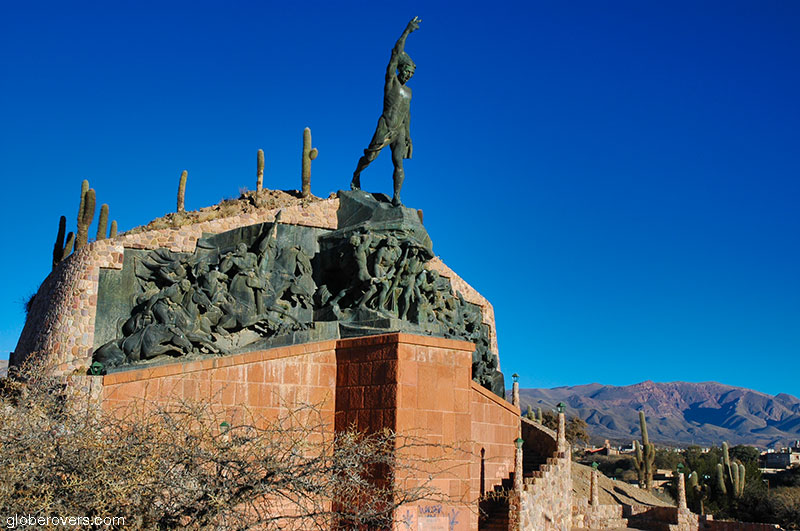
The San Francisco Solano de la Bendición is a Franciscan church in the main plaza, and well worth a visit, mainly for its unique bell-tower. Every day at precisely 12-noon, the heavy copper doors of the bell-tower slowly open, and a life-size animated wooden statue of San Francisco Solano appears for about two minutes. He makes the sign of the cross and bestows his blessing on believers and passersby on the village plaza before returning to his tiny home inside the bell-tower.
Also check out the artisan market at Centro de Artesanías Tantanahue, folkloric music and dancing at selected venues including restaurants, and red pottery shops creating vivid red earthenware craft pottery.
Make sure to taste llama meat stews and many delectable dishes from the Quebrada de Humahuaca, such as quinoa empanadas (a small baked pie), locro (hearty thick stew), tamales (dough steamed in a corn husk), humitas (steamed corn cakes similar to tamales), charqui (dried, salted meat), and many more local delicacies.
About 25 kilometres (15.5 mi) east of Humahuaca lies the Serranía del Hornocal mountain range at a height of 4,761 metres (15,620 ft) with its multi-coloured jagged landscape. The colours are most vivid in the late afternoon and immediately after sunset.
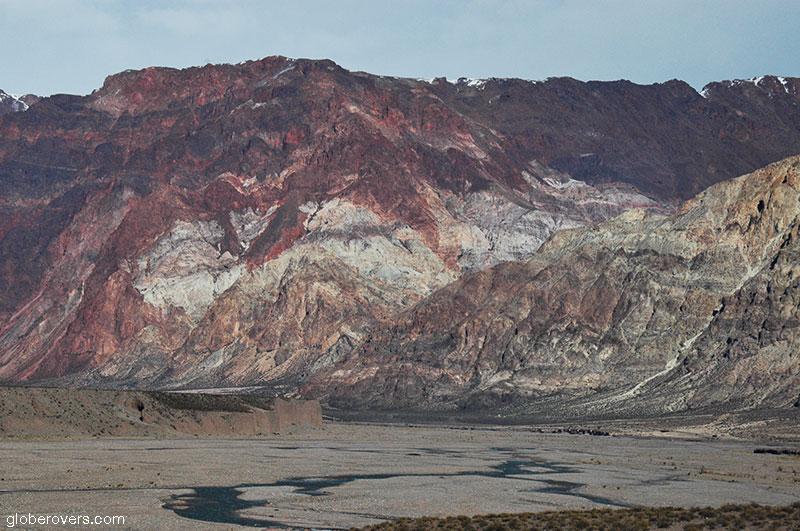
Driving south of Humahuaca along Route 9 to Purmamarca with its Cerro de los Siete Colores (The Hill of Seven Colours) is a world of dazzling red rocks in all directions. Purmamarca is considered to be one of the most picturesque villages in the Quebrada de Humahuaca, so it is not to be missed.
Enroute, spend a day or two at Tilcara, about 26 kilometres (16 mi) from Purmamarca. Tilcara is a small village with a lively town square, a few bars and restaurants, and plenty of historical and natural sights to adore.

Don’t miss the Pucará de Tilcara, a pre-Inca fortification on a hill just outside of town.
The drive southward from Purmamarca to Salta takes less than three hours though you will be tempted to stop frequently for the views.
Salta
Salta, the capital of Argentina’s Salta Province, lies in the Lerma Valley at 1,152 metres (3,780 feet) above sea level and has a population of well over half a million.
Founded in 1582, Salta is known for its Spanish heritage and colonial architecture.
A great start to exploring the streets and architecture of the city is to survey it from above. Board the teleférico (cable car) from Parque San Martín and reach the top of Cerro San Bernardo Hill in less than 10 minutes.
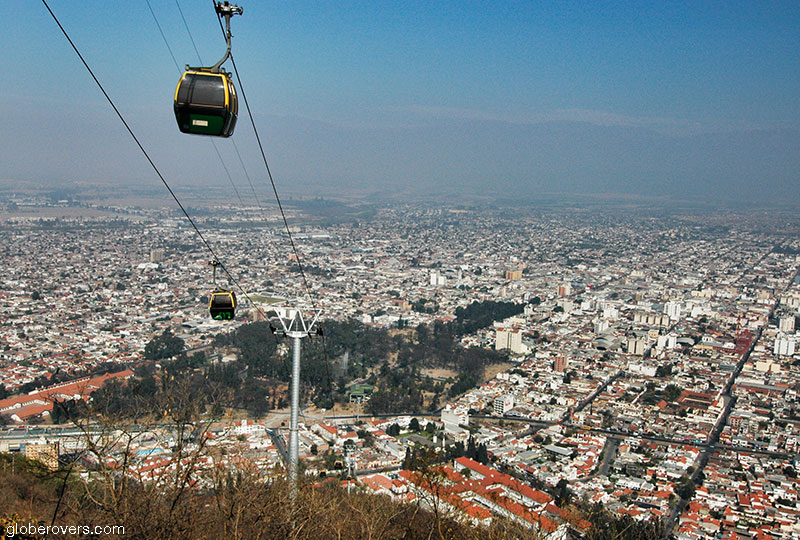
Alternatively, take the trail with many stairs starting at the Güemes Monument, or just drive up by car. At the top of the hill, you will find a wine bar operated out of a tricked-out bicycle and wagon, and several handicraft shops.
Salta’s palm tree-lined main square, Plaza 9 de Julio, is surrounded by Spanish colonial architecture, cobblestone streets and cosy cafes. Along the square is Salta’s most recognizable sight, the magnificent light-pink neoclassical Catedral Basílica de Salta with its brilliant red, gold, green, and blue interior.
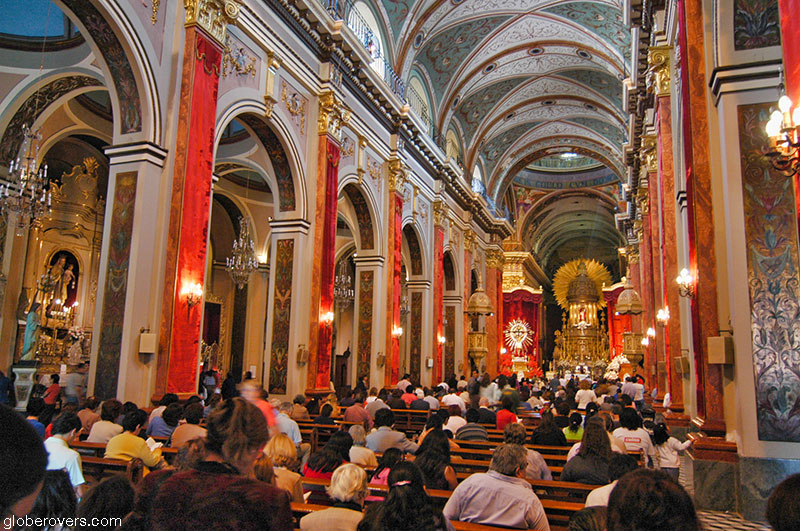
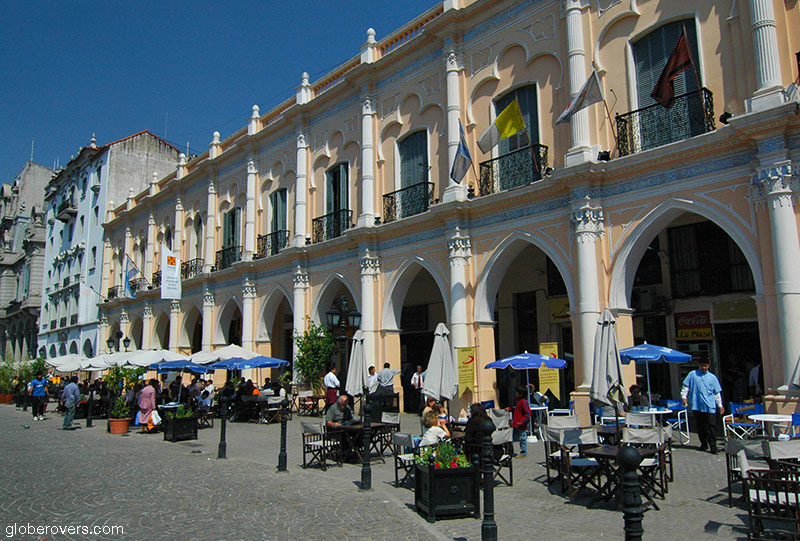
Time stands still in certain parts of the city with its preserved cobblestone streets and Spanish architecture
thecrazytourist.com
Also along the square is the white-washed El Cabildo de Salta, the colonial town hall which nowadays serves as the Historical Museum of the North. The current building was constructed in 1780 while the tower was completed several years later. Since its completion, the building has served many purposes including police headquarters, government house, a private compound, and even a hotel. Since its full restoration in 1945, it is the most complete and best-preserved town hall in all of Argentina.
Sit under the umbrellas outside the El Cabildo and order a cold Salta Cerveza (beer).
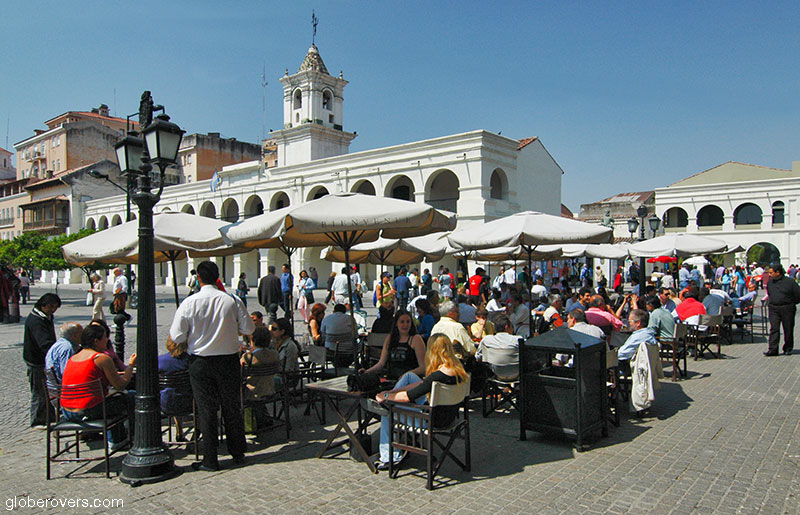
As we’re on the long way down to the world’s southernmost town of Ushuaia, we continue southeast of Salta on a rather long detour to the Iguaçu Falls before turning southwest to the nation’s capital, Buenos Aires.
Iguazú Falls
The spectacular Iguazú Falls lie over 1,400 kilometres (870 mi) east of Salta on the tri-junction of Argentina, Brazil and Paraguay. The Iguazú River, with a drainage basin of 62,000 km2 (24,000 sq mi), is 1,320 kilometres (820 mi) long.
Iguazú Falls is the largest waterfall system in the world.
The falls, which divide the Iguazú River into the upper and lower Iguazú, are the largest waterfall system in the world. While most of the river flows through Brazil, the largest section (about 80%) of the falls is on the Argentinian side.
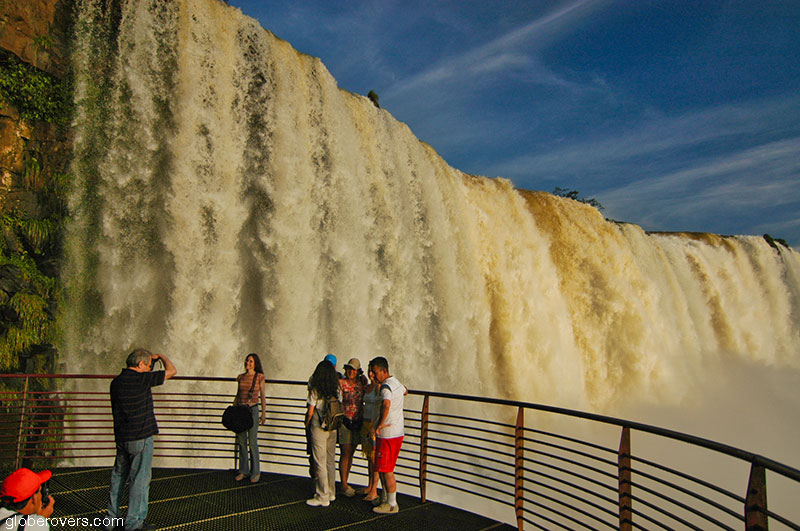
While Iguazú Falls, at over 1,600 metres (5,249 ft) wide and over 100 metres (328 ft) in height, is wider than the Victoria Falls in Southern Africa, the latter has a much larger “solid curtain of falls” in high-flow season. Iguazú is split into roughly 275 distinct falls by river islands and therefore is not a wide solid curtain. Most of them are about 64 metres (210 ft) in height.
The most impressive of them all is the Devil’s Throat U-shaped falls at 80–90 metres (262–295 ft) wide and 70–80 metres (229–262 ft) high.
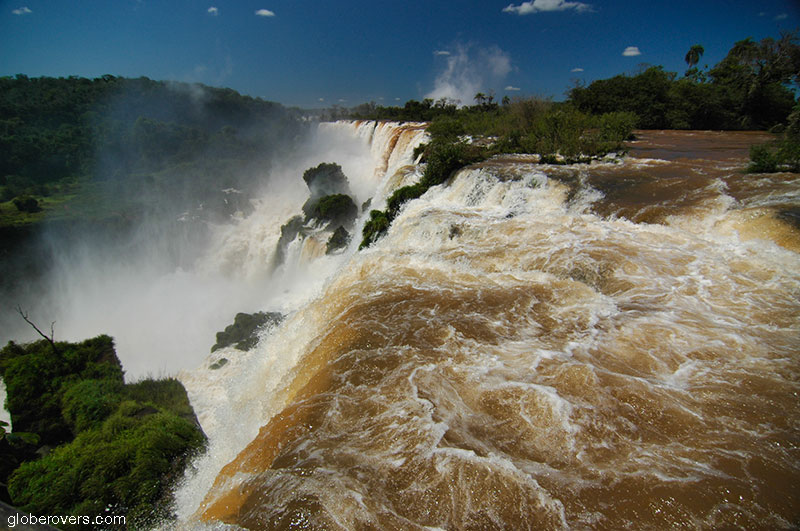
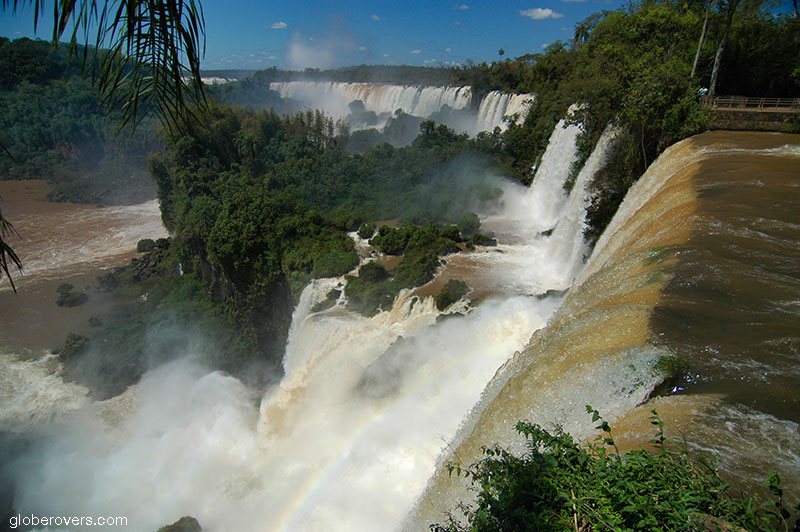
Iguazú Falls is generally listed as the world’s biggest waterfall, followed by Victoria Falls, Niagara Falls, and Venezuela’s Angel Falls which is also the world’s highest.
Iguazu waterfalls are unquestionably more impressive than the Niagara Falls in Canada / USA!
Gary Ottawan
While it is easy to watch the plunging waters all day long from several vantage points, there are a lot more things to do at Iguazú Falls than simply to marvel at their beauty.
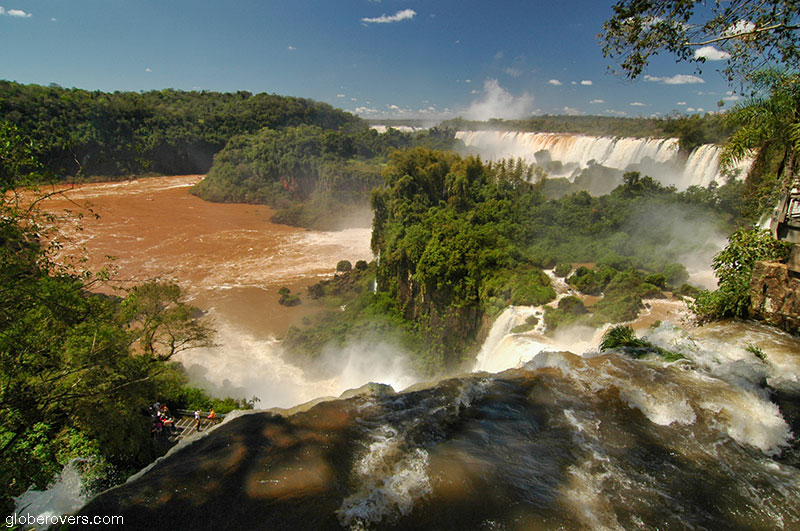
On the Brazilian side, go on the Macuco Jetboat Safari. At $65 for an adult, this is a speedboat ride you won’t easily forget. The boat takes you right into the Devil’s Throat where you run rapids and ride right under the thunderous falls located on the Argentinian side. As you get thoroughly drenched, you will know that you survived a ride underneath one of the world’s greatest waterfalls.
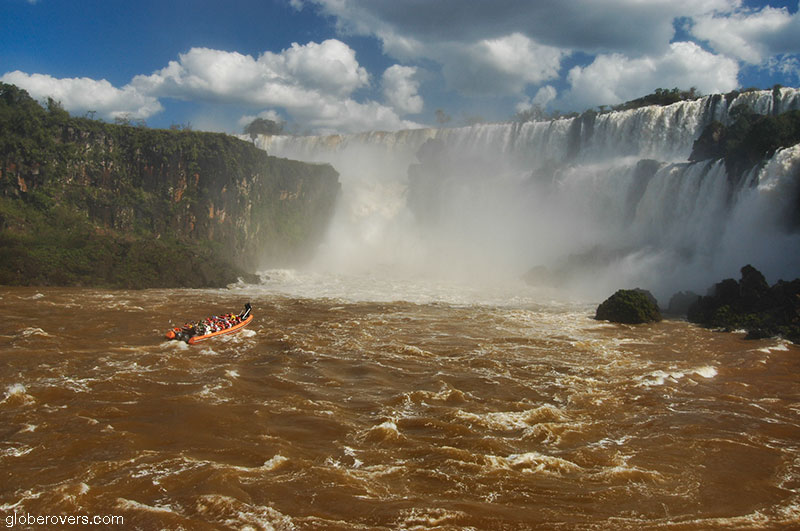
Also on the Brazilian side is the Parque das Aves, where you can get close to several bird species, including toucans, macaws, scarlet ibises, flamingos and parrots located in three immersion aviaries. You’ll also find reptiles such as alligators, anacondas and boas.
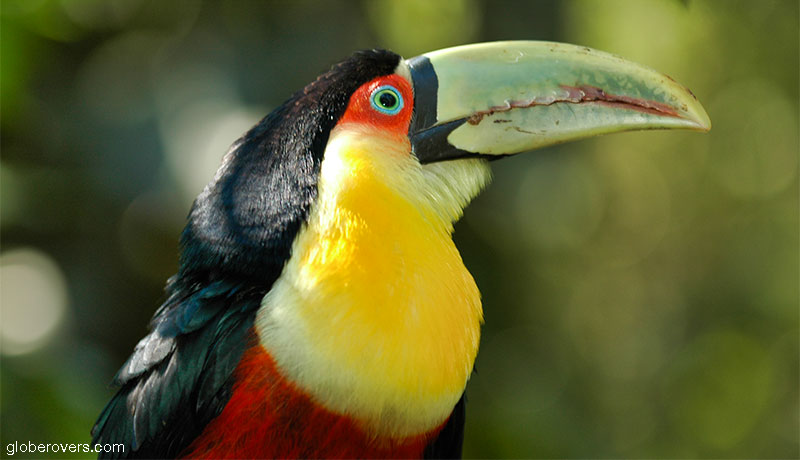
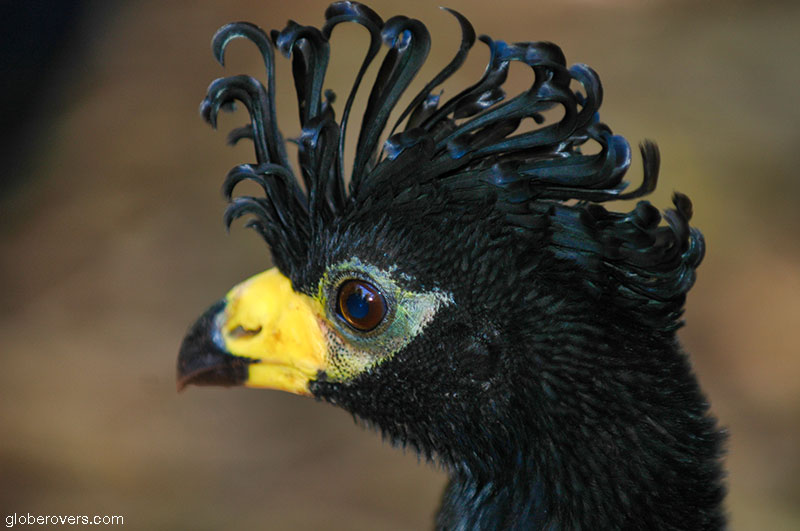
Helicopter rides over the falls are available though they are quite pricey. You can also hike, bike, and paddle around the area, in addition to going on a guided jungle safari.
Just 13 kilometres (8 mi) north of the falls is the Itaipu Dam, once billed as the “largest dam project on earth” until China’s Three Gorges Dam Project overshadowed it. A sunset tour by catamaran is a great way to end your day.
The falls divide the river into the upper and lower Iguazu. Some of the falls are over 80 m (269 ft) in height, though the majority are about 64 m (210 ft)
All these activities will work up a good appetite, so try one of the authentic restaurants located in the area of the falls where waiters serve an endless selection of prime meat cuts to your table.
Choose from pork, lamb, chicken and every cut of beef you can think of. Eat as much or as little as you like.
Buenos Aires
The road from the Iguazú Falls to the nation’s capital, Buenos Aires, stretches for almost 1,300 kilometres (807 mi) along the border with Brazil and Uruguay. Located south of the Rio de la Plata River on the Atlantic Coast, the name Buenos Aires means “good air”, for a very good reason.
Capital and largest city of Argentina, BA is a feast for all the senses
Buenos Aires is a city where you may want to linger for a few days, or even a few weeks or months. Many travellers have come here and stayed for years. Once the city, locally known as BA, is in your blood, it is hard to remove yourself from its loving arms. No wonder some people describe the city as ‘seductive’.

As the capital of Argentina, and also one of the largest cities of South America, the people of BA are known as the “Porteños” or “people of the port”. Considered to be the “pearl city” of South America, it is one of the least expensive cities in the world.
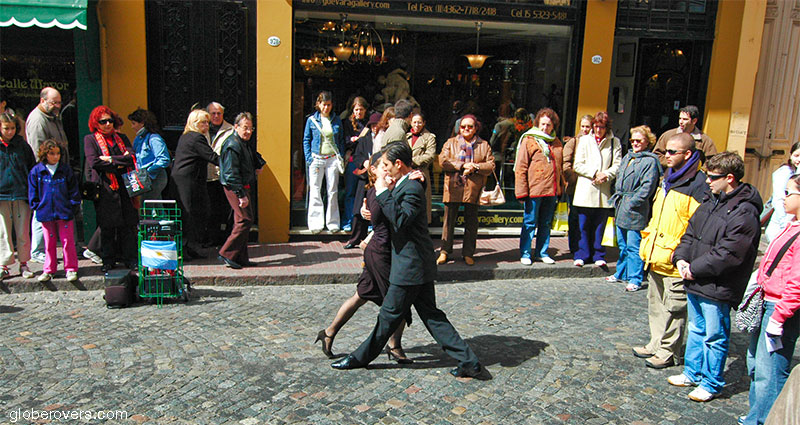
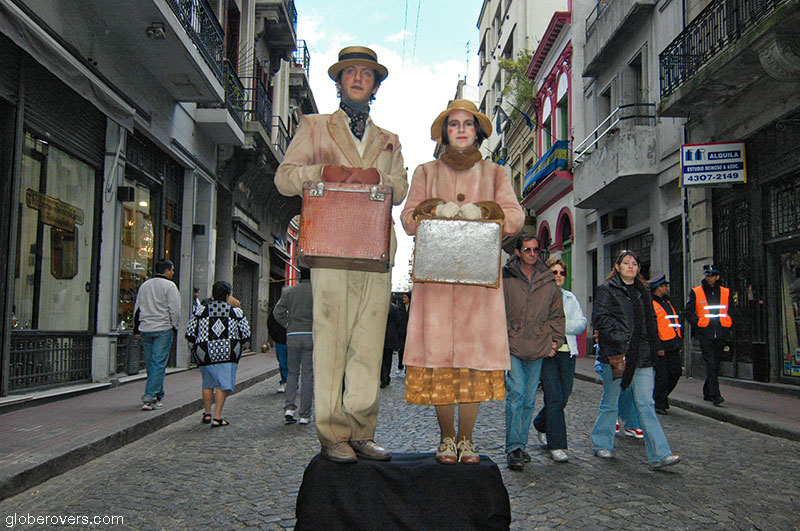
The recent decline in the value of the Argentinian Peso has made it even more affordable, though get in quick before a spike in inflation erodes its affordability.
Few cities will tug on your heartstrings more than Buenos Aires — the city of tango, food, wine, and barrios with great personalities
Many travellers visit BA for tango dancing in the streets, the parrilla (BBQ) restaurants, parks such as the Reserva Ecológica Costanera Sur and the Bosques de Palermo, and the open-air markets. However, BA is best understood and appreciated by knowing, and enjoying its 48 distinctive neighbourhoods known locally as barrios, each with its own personality and special characteristics. The most popular barrios include:
- Palermo, BA’s most populated barrio, has a young vibe that attracts expats, foreign visitors and an ever-growing number of porteños (local residents). Here you will find boundless cafés and restaurants, bars and nightclubs, parks, botanical gardens, a zoo, museums and galleries, shops, and artisan markets. Its tree-lined cobblestone streets are a favourite haunt for backpackers, hipsters, designers and digital nomads. During your visit, you will no doubt end up spending time in Palermo.
- Recoleta is an upscale area with well-dressed locals meandering along exclusive avenues and dining in chic cafés and trendy bars. It has countless plazas, parks, museums, the national library, and is home to the Recoleta cemetery, a must-visit for graveyard enthusiasts. Here you will find the family tomb of Eva Mara Duarte de Perón (aka ‘Evita’), Argentina’s First Lady from 1946 to 1952. The graveyard covers an area of about 55,000 m2 (592,000 sq feet) and is a mini-village of tombs, some lavish while others crumble.
- Puerto Madero is the old port district transformed into a trendy area with hotels and restaurants. Historically, this busy old port was the heart of the city, though it only functioned as a port for about 15 years from 1897. The increasingly large cargo ships quickly rendered the port obsolete and so a new port was opened in 1911. The ships and warehouses have now made space for an upmarket area with high-end night haunts, a rotating footbridge, a floating-ship museum, and the 864-acre Reserva Ecológica Costanera Sur, popular with birdwatchers.
- Belgrano is one of the largest barrios and is a pleasant neighbourhood for aimless strolling and admiring residential homes. The barrio’s square, Plaza Manuel Belgrano, offers a weekend artisan fair where locals show off their handicrafts and jewellery.
- San Telmo is blessed with cobblestoned streets, colonial buildings with crumbling facades, an amazing weekly street market, and many great restaurants and bars. With a very humble beginning as home to the poor, its past has been left behind. Today San Telmo is a Bohemian enclave dotted with designer boutiques, cafes, tango parlours, and is described by many as the city’s most fashionable barrio. Be here on Sundays when the antique market and street party turns Calle Defensa street into the hippest place in town.
- Monserrat is home to many significant public buildings and the famous Plaza de Mayo. In fact, the entire city of Buenos Aires was built around the plaza and many of Argentina’s historical events took place here. In 1810, Plaza de Mayo was the focal point of the revolution that triggered the War of Independence against the Spanish colonialists. Surrounding this plaza are historical buildings and architectural masterpieces such as the pink Casa Rosada, office of the President of Argentina. Nearby is the Museo del Bicentenario, the Cabildo (Town Hall), the Catedral Metropolitana, Museo Histórico Nacional del Cabildo y la Revolución de Mayo, and several galleries and churches.
- La Boca sits at the mouth of the Matanza River and is known for its colourful buildings and music, a buzzing barrio where tango dancers rule the streets and houses resemble a painter’s palette, awash with all hues and colours. Caminito, the main street, is every bit as colourful as the La Boca houses, complete with fairs of artists and painters and tango shows. Here you will also find La Bombonera, the 49,000-seat football stadium that is home to the much-beloved Boca Juniors team. Don’t miss a match when they are playing on their home turf.
- Caballito is in the geographic centre of the city and a great place to check out the colonial-style mansions on Avenida Rivadavia. Parque Rivadavia has a daily market packed with all kinds of interesting items. Interested in historical tramways? On Saturdays, Sundays and public holidays, take a free two-kilometre loop ride on the Tranvía Histórico trams lovingly maintained by Amigos del Tranvía (friends of the tramway) Association.
While BA offers an array of dining experiences, nothing comes close to dining at the 25-year old Siga la Vaca chain of restaurants, which is exclusively for serious carnivores.

Need a break from the big city? Just 32 kilometres (20 mi) northwest of the city is the town of Tigre, a picturesque town on the banks of the Luján River and the Río de la Plata. The most economical way to Tigre is via the Linea Mitre train which begins at BA’s Retiro station. This is an interesting experience complete with roving onboard merchants selling anything you may need. However, for those who want to travel in style, the 11-station light rail line, Tren de La Costa (Coastal Train), takes tourists to various stops along the river with picturesque views of the Paraná Delta.
Alternatively, go by bus or take a boat trip to Tigre from the barrio of Puerto Madero.
Once in Tigre you can walk around the interesting town, along the river or take a boat tour among the Parana Delta Islands. Don’t miss the Museo de Arte Tigre which is housed in one of Tigre’s most stunning Belle Epoque palaces. The museum focuses on Argentine art from the 19th and 20th centuries by masters such as Antonio Berni, Raúl Soldi, and Eduardo Sivori.

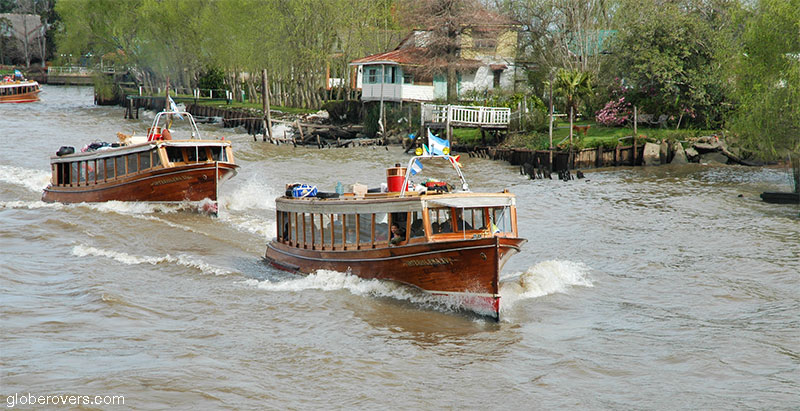
Peninsula Valdez
One of the best areas to experience wildlife in Argentina is at Peninsula Valdés, a Patagonian coastal nature reserve. Located in the Argentinian Province of Chubut, the peninsula is known for its conservation of marine mammals with a large breeding population of the endangered southern right whale as well as active breeding populations of southern elephant seals, southern sea lions and thousands of nesting Magellanic penguins.
One of the biggest attractions in this area is observing the unique hunting strategy of the killer whale or orcas—a coordinated strategy to encircle and push their prey into shallow waters where they are devoured.
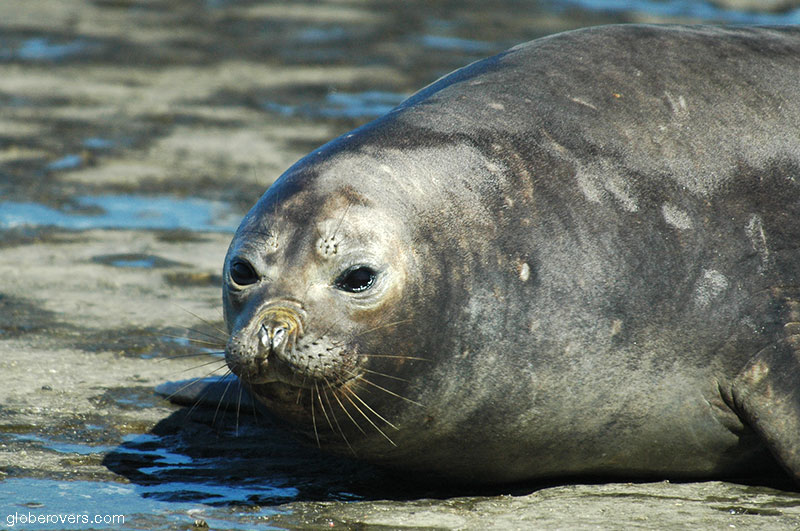
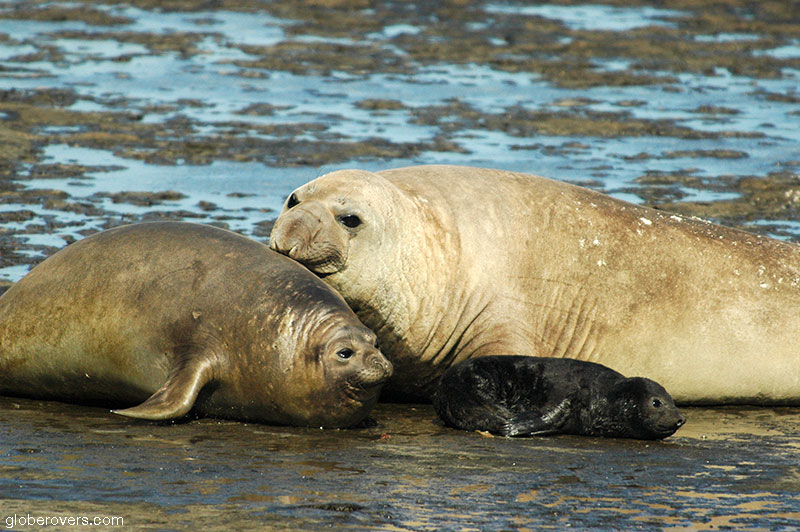
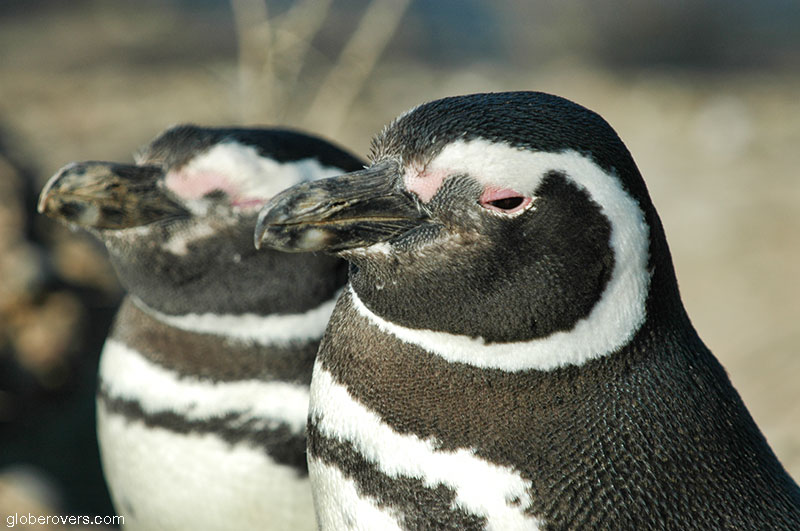
In addition to roughly 400 kilometres (249 mi) of unspoiled shoreline, the mushroom-shaped peninsula also boasts rocky cliffs of up to 100 metres (328 ft) high, shallow bays, shifting coastal lagoons with extensive mudflats, pebble beaches, large sand dunes, and a few small islands.
Península Valdés is best known for its protected marine animals
The land ecosystem is dominated by the Patagonian Desert Steppe with herds of guanacos, one of South America’s native camelid species and cousin of the llama.
You may also get to see the Patagonian mara, a rodent endemic to Argentina, and plenty of birds including the migratory snowy sheathbill, white-headed steamer duck and the ostrich-like flightless lesser rhea.
Patagonia’s Peninsula Valdés is home to an active breeding population of endangered southern right whales, southern elephant seals, and southern sea lions
Punta Pirámides is famous for its sea-lion rookery and cormorants that can be viewed from the cliffs high above.
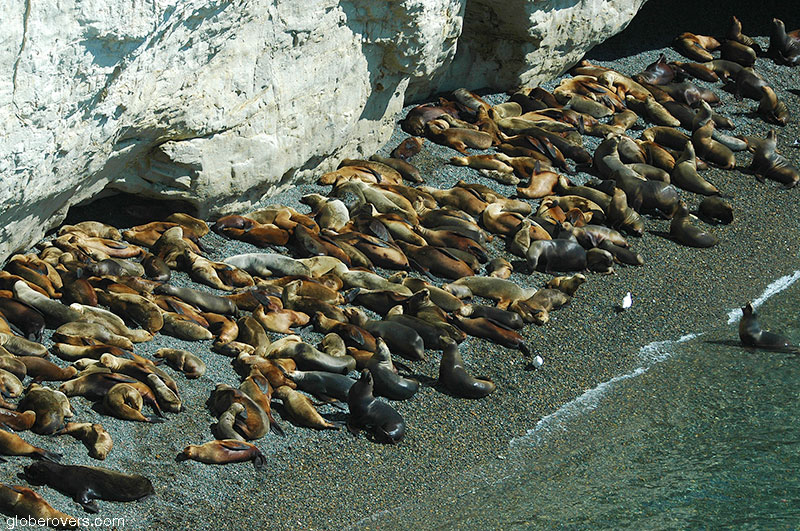
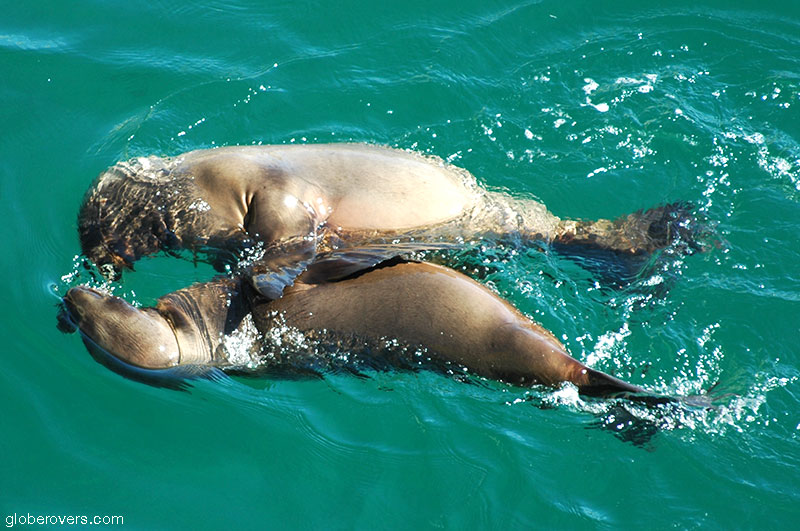
While you may need a few weeks to see all the animals that make their home at Peninsula Valdés, even a one-day trip from the nearby town of Puerto Madryn is a must-do.
Over 800 kilometres (497 mi) northwest of Peninsula Valdés is the town of Bariloche. Situated in the foothills of the Andes Mountains on the southern shores of Lake Nahuel Huapi, it is a long detour but the rewards are immense.
The ski resort at Cerro Catedral is the biggest in the southern hemisphere. Swimming in the lakes, fishing, whitewater rafting, hiking, and bird watching are some of the many reasons to visit.
Patagonia Glaciers
Southern Argentina has well over 300 glaciers. Many of them located in the Los Glaciares National Park, a UNESCO World Heritage Site in Argentina’s Santa Cruz province. Ice covers over 40% of this national park with about 47 glaciers, all of which are fed by the Southern Patagonian Ice Field which holds the world’s third-largest reserve of freshwater.
Patagonia’s glaciers are among the world’s most impressive and accessible
Perito Moreno Glacier, one of the largest, most impressive, and most accessible glaciers in the park, covers an area of 250 km² (97 sq mi) and is about 30 kilometres (19 mi) in length. The glacier’s terminal (front-face) is 5 kilometres (3.1 mi) wide, with an average height of 74 metres (240 ft) above the surface of Lake Argentino. Its total ice depth at the terminal is 170 metres (558 ft).
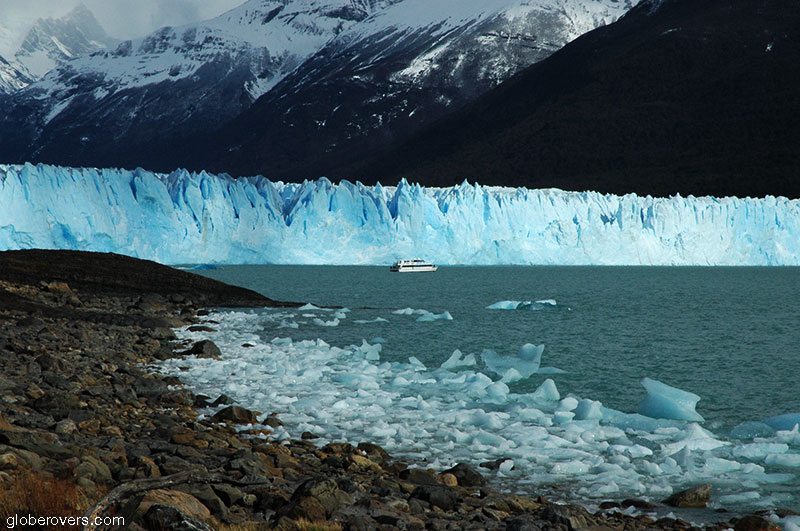
While most glaciers worldwide are retreating, glaciologists claim that Perito Moreno is one of only three Patagonian glaciers actually growing.

A full day visit allows for views from different vantage points around the terminal of the glacier. The surrounding hills offer spectacular views of the glacier while other glaciers along the lake (e.g. Upsala Glacier) can be visited by catamaran, kayak, or 4×4 excursions.
Argentina’s southern Patagonia region is famous for its Los Glaciares National Park with several massive glaciers fed by the Southern Patagonian Ice Field
Glacier hikes are offered, and as long as you are very careful you won’t die a slow icy death. Join a local glacier-hiking group with a guide, put on your crampons (spiked ice-boots), secure the ropes, and get onto the glacier. An unforgettable hike indeed!

Perito Moreno Glacier is a 90-minute ride (78 km / 19 mi) west from the town of El Calafate (pop. 6,500). The town is a convenient base for many scenic spots in the area, including the spectacular flamingos that congregate on Lake Argentino. While in the area, take a three-hour drive up to El Chaltén, a small mountain village located on the riverside of Rio de las Vueltas which is known as “Argentina’s Trekking Capital.”
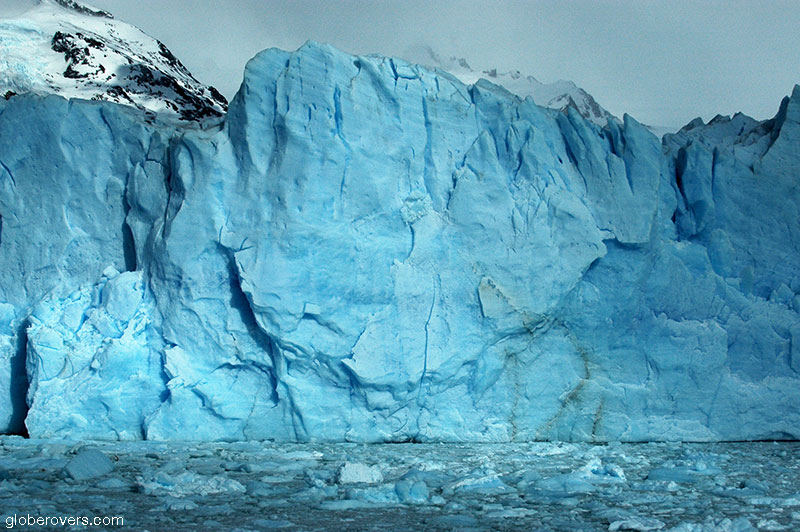
As the crow flies, roughly 40 kilometres (25 mi) south of Perito Moreno lies the equally impressive Upsala Glacier, one of the largest glaciers on the South American continent with a surface area of 765 km² (295 sq miles), 53.7 kilometres (33.3 miles) long and 70 metres (230 ft) high. Back in 1986, the area of the glacier was 896 km² (346 sq miles), so it has shrunk significantly. Occasionally, large portions of the glacier break loose that create “floating isles” on Lake Argentino.

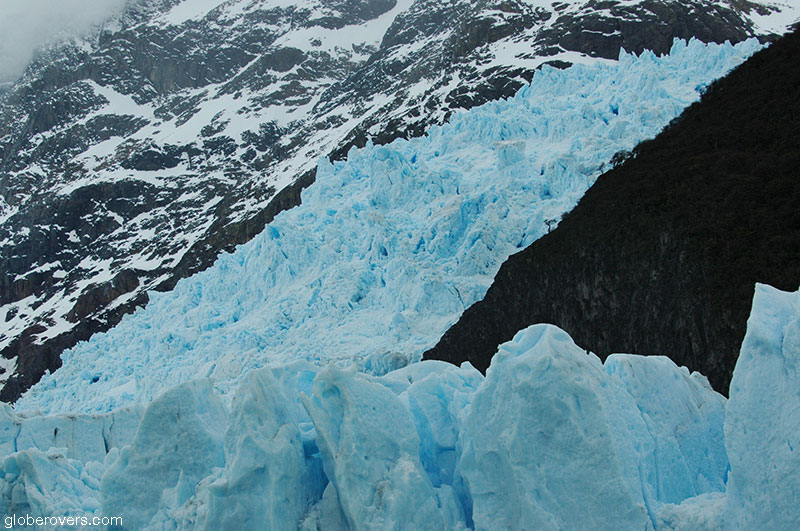
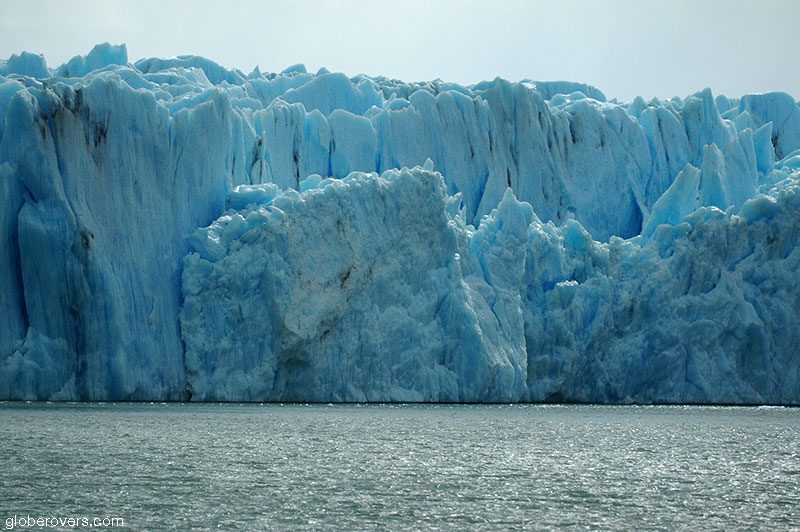
Southeast of El Calafate, a half-moon detour of almost 300 kilometres (186 mi) by road, is the Torres del Paine National Park in Chile, one of the most beautiful mountain landscapes in the world.
Ushuaia
Ushuaia, pronounced [u’swaia], is the capital of the province of Tierra del Fuego in southern Argentina. Lonely Planet Travel Guide describes the town as “A sliver of steep streets and jumbled buildings below the snow-capped Martial Range. Here the Andes meets the southern ocean in a sharp skid, making way for the city before reaching a sea of lapping currents”. How idyllic!
The world’s southernmost town is also the gateway to a lot of adventure
While this is not the most southern settlement, it is generally labelled as the “southernmost town” in the world, a title long disputed by the much smaller Puerto Williams.
Although Puerto Williams, southeast of Ushuaia on the Chilean island of Navarino, is farther south, it has only 2,900 inhabitants compared with Ushuaia’s population of more than 60,000. As Ushuaia is commonly regarded as the “southernmost town,” it leaves Puerto Williams with the title of “southernmost village.”
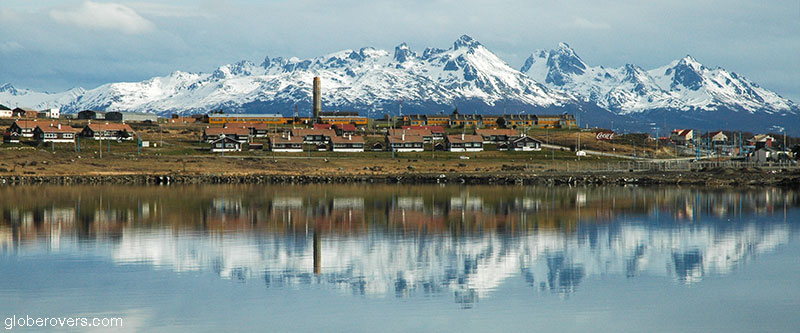

Ushuaia is located in a wide bay on the southern coast of the island known as “Isla Grande de Tierra del Fuego.” Guarded on the north by the Martial Mountain Range and on the south by the Beagle Channel, the first humans to settle in the Tierra del Fuego date back about 10,000 years when the Selk’nam Indians, also called the Ona, arrived. Their southern splinter group, referred to as the Yaghan or Yámana, occupied the area which now is known as Ushuaia.
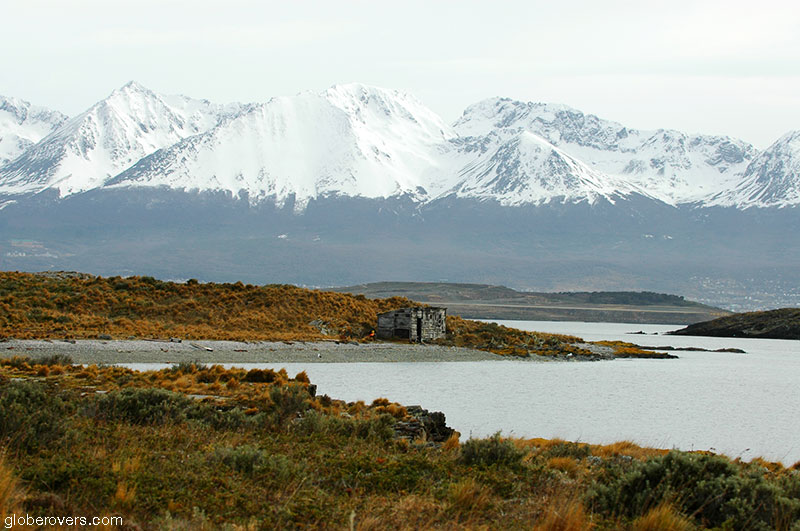
British missionaries founded the town of Ushuaia in 1884, and the town’s population slowly grew. However, epidemics including typhus, pertussis, and measles decimated the native population and by 1911 the Yámana had all practically vanished.
To boost the small population, the Argentine government started sending re-offenders and dangerous prisoners, as well as political prisoners from Buenos Aires to the new jail in Ushuaia which at this time was known as Presidio, meaning “the jail at the end of the world.
Being so close to the bottom of the world is a special feeling, in particular when you are surrounded by beautiful scenery and wildlife
The prisoners were subjected to hard labour both inside the prison grounds and outside. As forced colonists, they spent much of their time building the new town of Ushuaia with timber collected from the lush forest around the town. They also constructed a short railway to transport rock, sand and timber to expand the prison and the town.
The original train line was constructed in 1902 and shuffled around on wooden rails with flatbed wagons pulled by oxen. In 1910 a steam engine was brought in and the gauge was widened, presumably with steel tracks. The 1949 Tierra del Fuego earthquake caused a landslide which blocked much of the line just two years after the prison was closed, so gone were the labourers to remove the blockage. The blockage was cleared by non-prisoners but again closed in 1952 due to a lack of money.
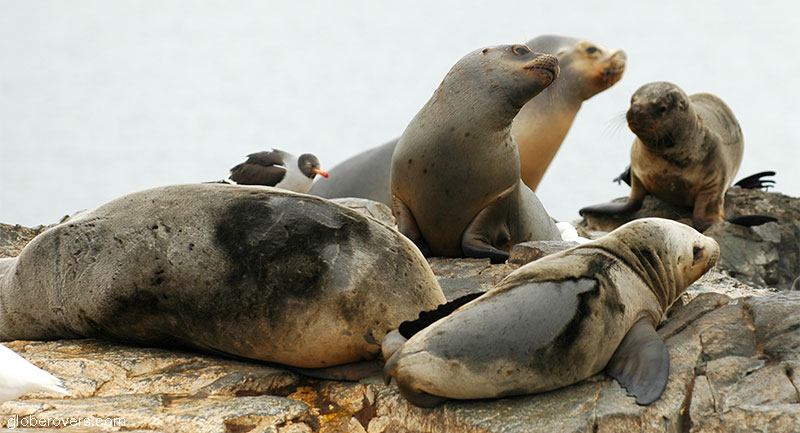
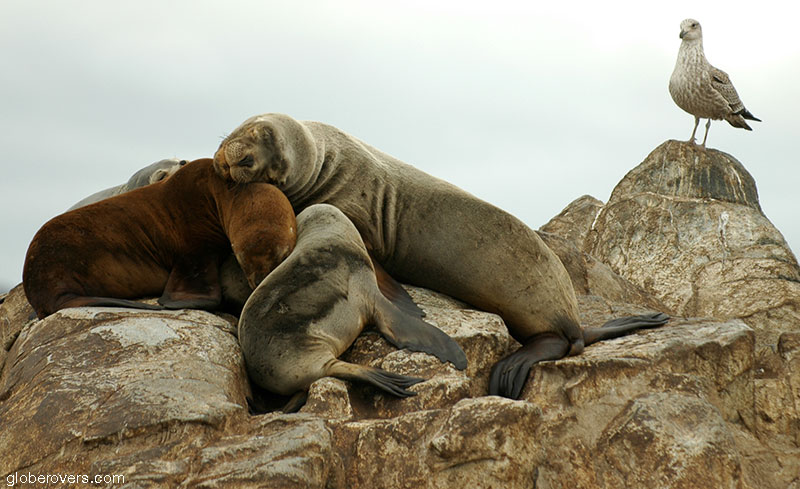
Fast forward to 1994 when the line was reopened and upgraded, with the addition of a new steam engine from England. Now known as the “Southern Fuegian Railway” or “End of the World Train,” it serves champagne and dinner to tourists on a short ride along Pico Valley in the Toro Gorge. At the Macarena Station passengers learn about the Yámana indigenous people and then continue on through the scenic Tierra del Fuego National Park.
Guess what? It is indisputably labelled as the “southernmost railway in the world.”
The original jail, closed in 1947 by President Juan Perón, today serves as a museum known as the Museo Marítimo de Ushuaia, which is the southernmost museum in the world, we assume! One of the cells known as the Ala Histórica remains almost intact to demonstrate the mysterious and dark atmosphere inside the cells, complete with memorabilia from the last prisoners who lived here.
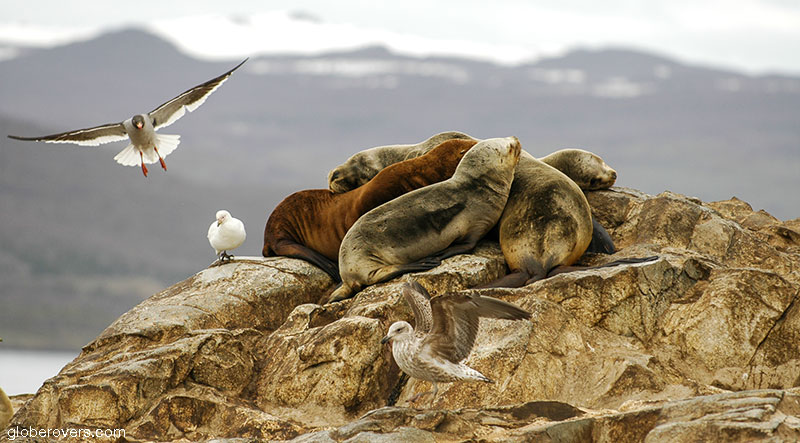
Another pleasant day trip is to explore the Beagle Channel and Lapataia Bay by boat. The channel, named after the explorer Charles Darwin’s ship which sailed here in 1833-34, separates Isla Grande de Tierra del Fuego from the southern islands of Navarino, Nueva, Lennox, Picton, and many other smaller islands.
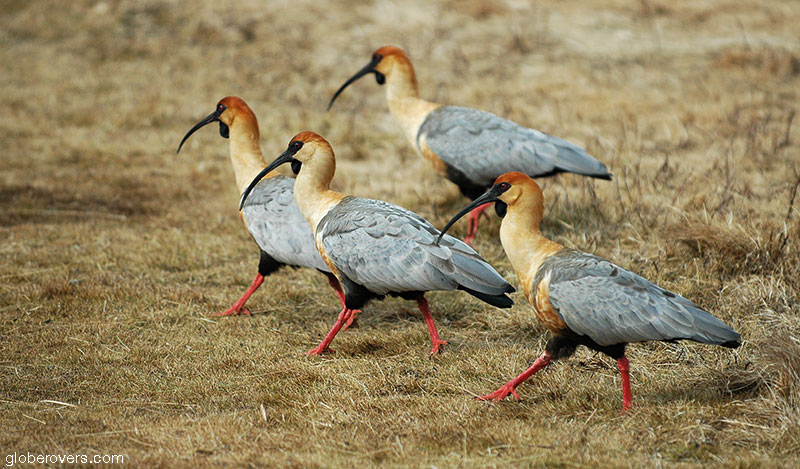
As your boat sails past the Les Eclaireurs Lighthouse and many islands, look out for breeding colonies of sea lions, imperial cormorants, dolphin gulls, and steamer ducks.
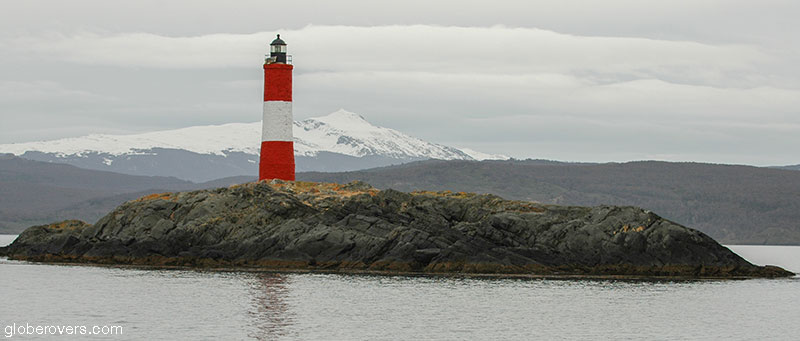
Tierra Del Fuego
From Ushuaia, it’s a pleasant day trip into the nearby Parque Nacional Tierra Del Fuego. Established in 1960 and expanded in 1966, the park is well-known for its dramatic scenery with waterfalls, forests, mountains and glaciers.
Look out for several species of mammals, including the guanaco, Andean fox, and the North American beaver. Ignore the many European rabbits as they don’t belong here, and neither do other introduced species such as Canadian beaver, muskrat rodent, mink and armadillo.

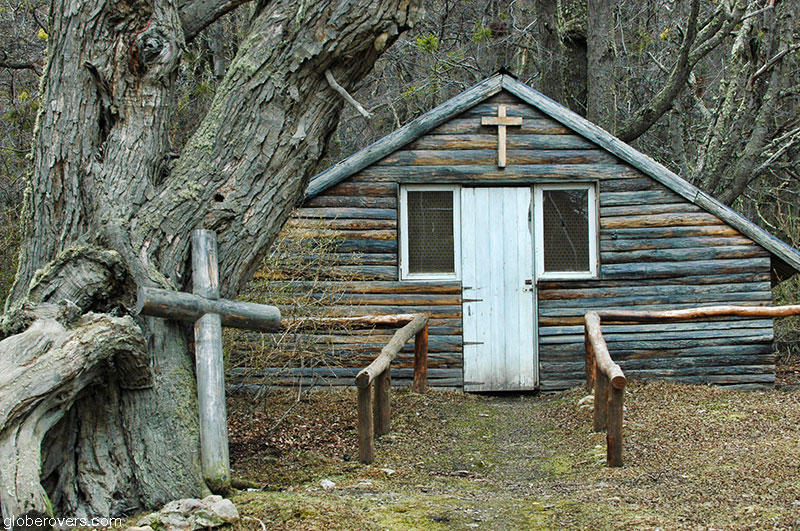
A few pairs of European rabbits were introduced to the Chilean side of Tierra del Fuego Island in 1936 and knowing these bunnies, they multiplied rapidly. Due to these unwelcome breeders, the ground in many parts of the park became riddled with holes, and some areas denuded of vegetation.
Tierra del Fuego National Park has dramatic scenery and wildlife
Back in 1950, the rabbit population was estimated to be a whopping 30 million. In an attempt to control them, grey foxes, which never existed on Tierra del Fuego Island, were released in 1951. The grey fox and the native Patagonian fox did not do much to control the rabbit population, so the much-feared myxoma virus that causes myxomatosis in rabbits was introduced. It almost decimated the entire rabbit population, however, some survived so today there are plenty of rabbits to be seen within the park.
Among the many species of birds in the park are kelp goose, upland goose, torrent duck, southern crested caracara, Austral parakeet, Andean condor, blackish oystercatcher, and the Magellanic oystercatcher.
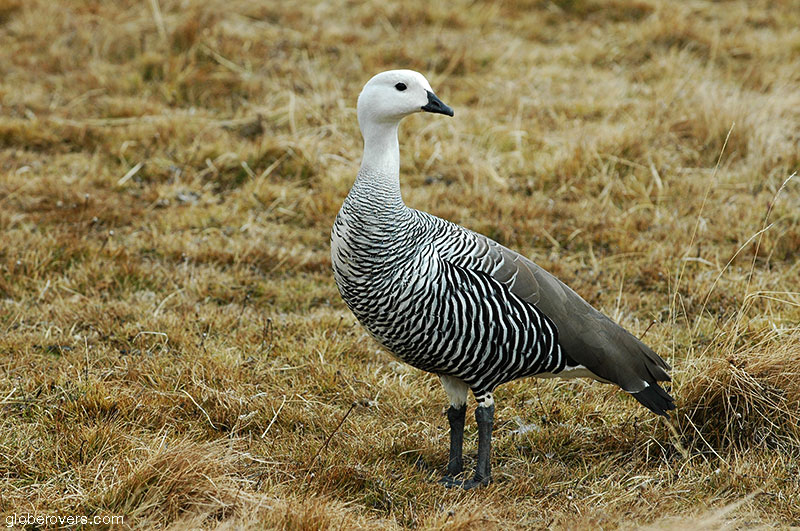
In addition to the fauna and flora, the park is also famous for being the southern terminus of the Pan-American Highway (National Route 3), a highway which runs 3,045 kilometres (1,892 mi) all the way from the nation’s capital, Buenos Aires.
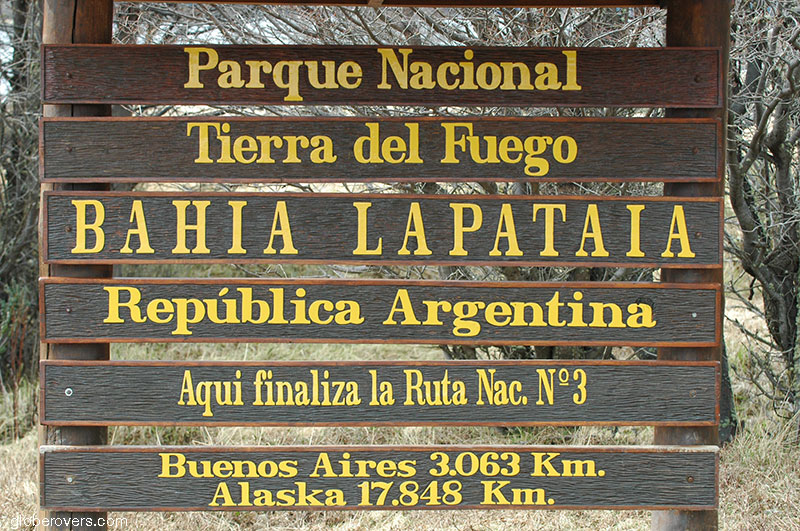
The Martial Range to the north of Ushuaia offers good ski runs. Taking the Aerosilla chairlift to the top during any time of the year offers spectacular panoramas over the mountains, Tierra Del Fuego Park, Ushuaia, and the Beagle Channel.
The 63,000 hectares Tierra del Fuego National Park stretches from the Beagle Channel to the edges of Lago Kami at the southernmost point of Argentine Patagonia.
At the exit of the chairlift is the Club Andino Ushuaia shelter which is a great place for a rest and a drink. From here the trail leads to the base of Glacier Martial, which runs alongside a little mountain river in its last stage. However, if conditions are favourable, the panoramic views are more impressive than the actual glacier. Glacier Martial has shrunk dramatically over the past century, as is shown in the photographs on display in the shelter’s café.
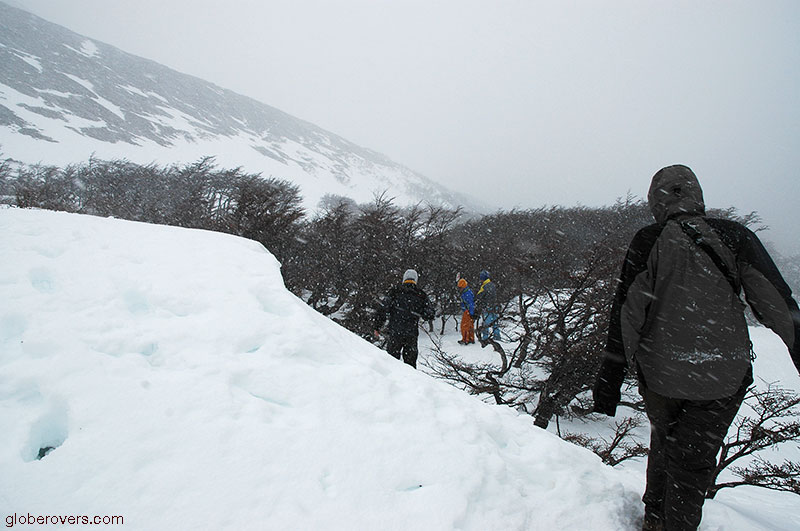
So now we have made it all the way down to Ushuaia and the Beagle Channel. Going any farther south, we will enter the most southern territory of Chile, Isla Navarino and the Wollaston Islands. Next stop is the Antarctic Peninsula which we will leave for next time.
Essential Information
Getting There
Several airlines offer regularly scheduled flights from Europe, the USA, and Canada. Flights from Asia and Africa are limited and often require a change in Europe, the USA, or in Central America (such as Copa Airlines based in Panama). A north-south journey is best started in La Paz, Bolivia, via the incredible Uyuni Salt Flats to Villazon on the border.
Getting Around
While an Aerolineas Argentinas “Visit Argentina Pass” will save you money, it is more fun to take the long road. Popular long-distance bus routes are served by several bus companies, some of which are super luxury and come at a reasonable fare. The bus routes are extensive and a highly recommended way to travel. Long-distance passenger trains are limited.
Photography
Argentina is a photographer’s playground. While the cities, Buenos Aires in particular, have many neighbourhoods of interest to urban living photographers, the country is packed with beautiful landscapes, in particular the mountains, ski resorts, national parks, waterfalls, Patagonia’s glaciers and lakes, wildlife hotspots such as Península Valdés, etc.
When to Go
Argentina is an all-year destination. It’s best to decide what you want to see and where you want to go. Avoid the December and January holidays. Generally, springtime (October to mid-December) and autumn (April to mid-June) are the best times to visit Argentina.
Where to Stay
The tourist infrastructure is well developed and accommodation is available in all price ranges, except for the smaller villages. Guesthouses and quality hostels are widely available. If you visit the Pampas lowlands, stay at a cattle and sheep ranch (estancias) and hang out with a cowboy.
Safety
Argentina is a modern country but has experienced a depressed economy in recent years. Petty theft is common in cities and muggings do happen. Argentina has a problem with drugs, which can make people unpredictable, so be careful. Nature should be your biggest safety concern.
Dining Out
Dining is the most important reason for many people to visit Argentina, in particular if you are a serious carnivore and a wine drinker. The BBQ asados are among the best in the world. These people are serious meat connoisseurs. Wines from the Mendosa region are excellent.
Packing
This is a laidback country so dress casually for most of the time. Your activities and the time of the year will determine the clothes you pack. Winters in the south can be quite cold and summers in Buenos Aires and the north are very hot. The coldest months are June and July.
Cost of Travel
While the Argentina Peso has been depreciating against the USD in recent years, it lost half of its value since early 2018. Now is a great time to visit, though inflation hit 48% in 2018 but is expected to cool down in 2019. Go soon to get great value for your foreign currency.
☛ Read more: 10 Great Experiences in Argentina

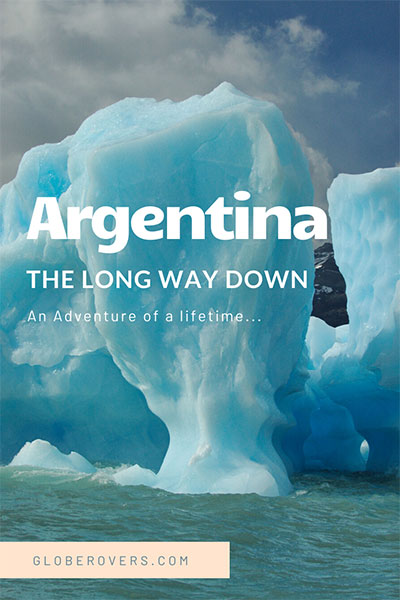
Further reading

Blog post and photos by Peter who has been travelling almost full-time since 2005 and has been to over 122 countries. He visited several countries, such as Japan, more than 20 times. Peter is Editor-in-Chief and Publisher of GlobeRovers Magazine, an independent travel magazine focused on intrepid destinations.
